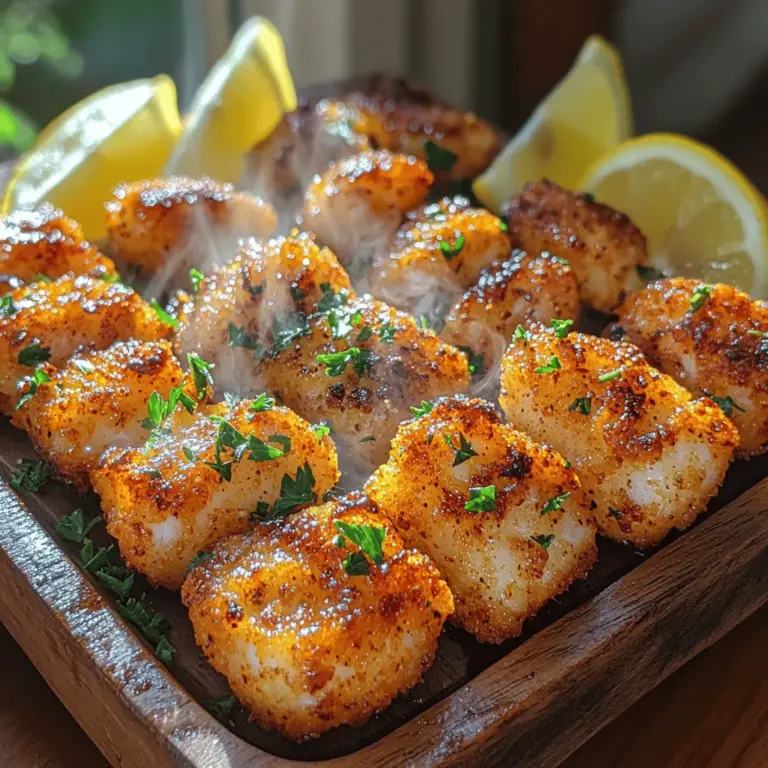Introduction
Cajun cuisine is a celebration of vibrant flavors, rich history, and a blend of culinary traditions that have developed in the heart of Louisiana. Influenced by the French, African, Spanish, and Native American cultures, Cajun cooking is known for its bold spices, hearty ingredients, and an unmistakable zest for life. Among the many delicious dishes that emerge from this culinary heritage, crispy Cajun catfish bites stand out as a delicious appetizer or a satisfying main dish that brings both comfort and excitement to the table.
The growing popularity of catfish in culinary circles is a testament to its versatility and adaptability. Once primarily associated with Southern cooking, catfish is now recognized for its mild flavor and firm texture, making it an excellent choice for various preparations. Not only do catfish bites deliver a delightful crunch and a burst of Cajun seasoning, but they also embody the spirit of communal dining, where food is meant to be shared, enjoyed, and celebrated.
The Appeal of Catfish in Cooking
Catfish is more than just a staple of Southern cuisine; it is a versatile and affordable fish option that allows home cooks and professional chefs alike to create an array of delectable dishes. With its mild flavor and firm, flaky texture, catfish easily absorbs marinades and seasonings, making it an ideal candidate for frying, baking, or grilling. Moreover, catfish is generally more budget-friendly compared to other fish varieties, making it accessible for families and individuals seeking delicious options without breaking the bank.
From a nutritional standpoint, catfish offers numerous health benefits. It is an excellent source of high-quality protein, which is essential for muscle growth and repair. Additionally, catfish is rich in omega-3 fatty acids, which are known for their heart-healthy properties. These nutrients play a crucial role in reducing inflammation, lowering blood pressure, and supporting overall cardiovascular health. With these advantages, catfish is not only a tasty choice but also a smart one for health-conscious diners.
In Southern and Cajun cooking, catfish holds a special cultural significance. It is often associated with family gatherings, community fish fries, and celebrations that bring people together. The tradition of catfishing along the rivers and bayous of Louisiana has deep roots in the local culture, where the catch of the day becomes the centerpiece of shared meals. By preparing crispy Cajun catfish bites, you’re not just making a dish; you are embracing a rich culinary tradition that honors the flavors and history of the region.
Essential Ingredients for Crispy Cajun Catfish Bites
To create the perfect crispy Cajun catfish bites, it is essential to select the right ingredients that will enhance both flavor and texture. Here is a detailed breakdown of each ingredient:
Catfish Fillets
When choosing catfish fillets, look for fresh fish that has a clean, mild scent. The flesh should be firm and moist, with a slightly translucent appearance. If you have the option, purchase catfish from a reputable source or fish market to ensure quality. Fresh catfish can be found year-round, but if you are looking for the best flavor, consider sourcing it from local suppliers or farms that practice sustainable fishing methods.
Buttermilk
Buttermilk plays a vital role in marinating the catfish, helping to tenderize the fish while infusing it with flavor. The gentle acidity of buttermilk breaks down the proteins in the fish, resulting in a succulent texture that contrasts beautifully with the crispy coating. When marinating, aim to soak the catfish fillets for at least 30 minutes, allowing the flavors to penetrate deeply. For an extra flavor boost, consider adding a splash of hot sauce to the buttermilk, which will complement the Cajun spices wonderfully.
Flour and Cornmeal
Creating the perfect crispy coating for your catfish bites requires a blend of flour and cornmeal. The combination of these two ingredients not only adds crunch but also contributes to a delightful golden-brown color during frying. All-purpose flour provides structure, while cornmeal enhances the texture, giving the bites that classic Southern crunch. You can adjust the proportions based on your preference, but a 50-50 ratio is a great starting point for achieving the ideal crispiness.
Cajun Seasoning
Cajun seasoning is the heart and soul of this dish, lending it the distinctive flavors that define Cajun cuisine. This spice blend typically includes paprika, cayenne pepper, garlic powder, onion powder, and dried herbs like oregano and thyme. Each ingredient works together to create a symphony of flavor that is both spicy and aromatic. While you can purchase pre-made Cajun seasoning, consider making your own to customize the heat level and flavor profile to suit your taste.
Optional Ingredients
For those looking to elevate their crispy Cajun catfish bites further, optional ingredients such as garlic powder, onion powder, and cayenne pepper can be added to the coating mixture. Garlic and onion powder offer additional depth of flavor, while cayenne pepper can amp up the heat for those who enjoy a spicy kick. Adjust these ingredients based on your personal preferences and the palates of your guests.
Importance of Seasoning and Freshness
When it comes to achieving the best flavor in your crispy Cajun catfish bites, the importance of seasoning and freshness cannot be overstated. Fresh ingredients not only contribute to the overall taste but also enhance the visual appeal of your dish. Seasoning is crucial; don’t be afraid to be generous with your spices. The right blend of flavors will elevate the catfish bites from ordinary to extraordinary, creating a dish that keeps your guests coming back for more.
Step-by-Step Instructions for Making Cajun Catfish Bites
Creating crispy Cajun catfish bites at home is a straightforward process that involves a few key steps. Whether you’re preparing these bites for a party, game day, or a family dinner, following these instructions will help you achieve the perfect results.
Overview of the Preparation Process
The process begins with marinating the catfish fillets in buttermilk, followed by dredging them in a seasoned flour and cornmeal mixture. Once coated, the catfish bites are fried until golden brown and crispy, resulting in a delectable treat that is sure to impress.
Marination
1. Prepare the Catfish: Start by rinsing the catfish fillets under cold water and patting them dry with paper towels. This step helps remove any excess moisture, ensuring a better coating later on.
2. Marinate in Buttermilk: Place the catfish fillets in a shallow dish and pour enough buttermilk over them to submerge the fish completely. If desired, add a few dashes of hot sauce to the buttermilk for an extra flavor boost. Cover the dish and refrigerate for at least 30 minutes, allowing the fish to soak up the flavors and tenderize.
3. Prepare the Coating: While the catfish is marinating, combine equal parts of flour and cornmeal in a separate shallow dish. Add in your Cajun seasoning along with any optional ingredients like garlic powder or cayenne pepper. Mix well to ensure an even distribution of flavors.
By following these initial steps, you set the stage for creating delicious crispy Cajun catfish bites that are sure to be a hit at any gathering.
{{image_1}}
Preparing the Breading
To achieve the perfect crispy exterior for your Cajun catfish bites, the preparation of the breading is crucial. Start by gathering your dry ingredients: cornmeal, all-purpose flour, and your selected Cajun spices. The key here is to mix the dry ingredients thoroughly. Use a whisk or a fork to ensure that the spices are evenly distributed throughout the flour and cornmeal. This not only enhances the flavor but also ensures that every bite is packed with that signature Cajun kick.
For an extra layer of flavor, consider adding additional seasonings like garlic powder, onion powder, paprika, or cayenne pepper. The balance of these flavors can elevate your catfish bites from simple to spectacular. Once your dry mixture is well blended, set it aside and prepare your fish for breading.
Heating the Oil
Proper oil temperature is vital for achieving that sought-after crispiness. Aim for a frying temperature of 350°F to 375°F (175°C to 190°C). If the oil is too cool, your catfish bites will absorb excess oil and become greasy. Conversely, if the oil is too hot, they may burn before cooking through.
To check the temperature without a thermometer, drop a small piece of bread into the oil. If it sizzles and turns golden brown within about 60 seconds, your oil is ready. Alternatively, you can use a deep-frying thermometer for precise results. Once the oil is ready, prepare to bread your fish.
Breading the Fish
Breading can be a bit tricky, especially if you want an even coating that doesn’t clump. Start by cutting your catfish fillets into bite-sized pieces, about 1 to 2 inches in size. Pat the fish dry with a paper towel; removing moisture is important for the breading to stick effectively.
Set up a breading station with three shallow dishes: one for flour, one for the egg wash (beaten eggs with a splash of milk), and one for the cornmeal mixture. Begin by dredging each fish piece in the flour, shaking off any excess. Next, dip it into the egg wash, allowing the excess to drip off, and finally coat it in the cornmeal mixture. Press gently to ensure an even coat, which will help achieve that crispy texture when frying.
Frying
When frying your catfish bites, it’s essential to work in small batches to prevent overcrowding the pan. This ensures that each piece cooks evenly and retains its crispiness. Carefully place the breaded catfish bites into the hot oil and fry for about 3-4 minutes or until they turn golden brown. Use a slotted spoon to flip them halfway through to ensure all sides are evenly cooked.
Once golden, remove the catfish bites and place them on a plate lined with paper towels to absorb any excess oil. This step is important to maintain the crunch. If you’re frying multiple batches, keep the finished catfish bites warm in a low-temperature oven while you complete the frying process.
Serving Suggestions
Presentation is key when serving your crispy Cajun catfish bites. Arrange them on a large platter and consider garnishing with fresh parsley or cilantro for a pop of color. Serve with lemon wedges on the side for an added zing.
For dips, traditional Cajun sauces like tartar sauce or remoulade work wonderfully. These creamy accompaniments contrast beautifully with the crispy texture and spicy flavor of the catfish. You might also offer a spicy aioli or a zesty hot sauce for those who enjoy an extra kick.
Flavor Profiles and Variations
Adjusting the spice level of your catfish bites can easily cater to different palates. For a milder version, reduce the amount of cayenne pepper or opt for a Cajun seasoning blend that is less fiery. Alternatively, for spice enthusiasts, consider adding diced jalapeños or a dash of hot sauce into the breading mix for an extra punch.
If you’re looking to play with flavors, try incorporating different seasonings such as Old Bay seasoning, lemon pepper, or smoked paprika into the breading for a unique twist. Experimentation is part of the fun!
When it comes to side dishes, think classic Cajun fare. Coleslaw is a popular choice, providing a refreshing counterbalance to the fried fish. Additionally, crispy fries or sweet potato fries pair well, offering a satisfying crunch alongside the catfish. For a heartier option, consider serving with a side of dirty rice or Cajun-style baked beans.
Cajun Cooking Techniques and Traditions
Cajun cuisine is deeply rooted in the culture and traditions of Louisiana, originating from the French Acadian settlers who brought their culinary techniques to the region. Traditional Cajun cooking emphasizes the use of fresh, local ingredients, and a variety of cooking methods, including frying, which is a staple technique.
Deep frying holds a significant place in Cajun cuisine, as it allows for the creation of crispy textures and rich flavors. This method is often used for seafood, meats, and even vegetables, showcasing the region’s bounty. The importance of communal dining in Cajun culture is reflected in how dishes like crispy Cajun catfish bites are often enjoyed in gatherings and family meals, celebrating togetherness through food.
Nutritional Information
When considering the nutritional content of crispy Cajun catfish bites, it’s important to remember that while they can be indulgent, they also provide a good source of protein. A typical serving of catfish (about 3 ounces) contains approximately 15-20 grams of protein, making it a healthy choice for those seeking a balanced diet.
However, due to the frying process, the calorie count can be higher than other cooking methods. Each serving of catfish bites can range from 300 to 400 calories, depending on the breading and cooking oil used. Portion sizes are key; serving alongside a salad or vegetables can help create a balanced meal. Moderation is essential, especially for those watching their dietary intake.
Conclusion
Crispy Cajun catfish bites are not just a dish; they are an experience that encapsulates the vibrant flavors and rich culinary traditions of Cajun cooking. With their crunchy exterior and tender, flavorful fish, they are sure to be a hit whether you’re hosting a gathering or enjoying a casual family meal.
Don’t hesitate to try this recipe at home and explore the bold and exciting flavors of Cajun cuisine further. These catfish bites can serve as a delicious introduction to a world of culinary possibilities, inviting creativity in the kitchen and enjoyment at the dining table. Enjoy every bite as you share this delightful dish with friends and family, making lasting memories over a shared love for good food.


